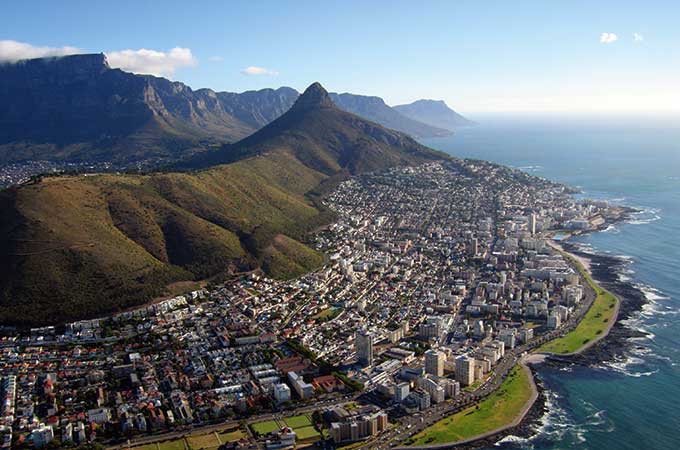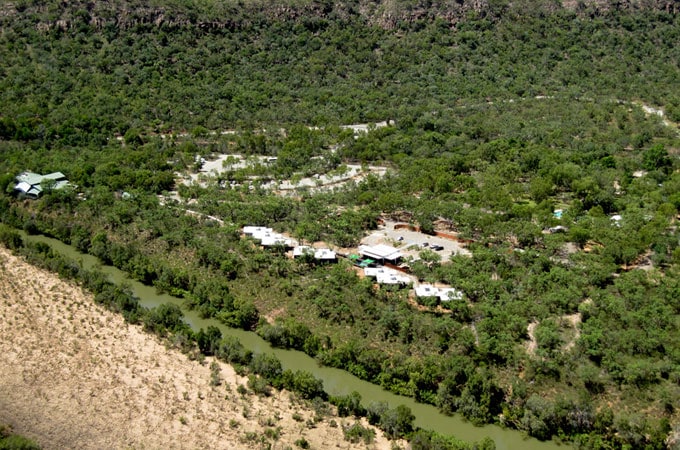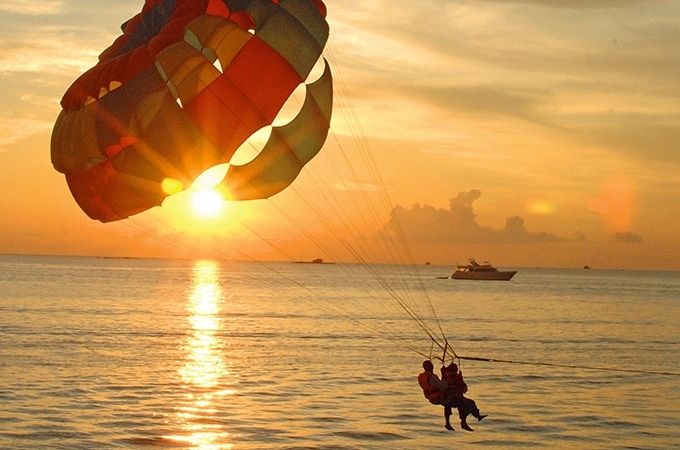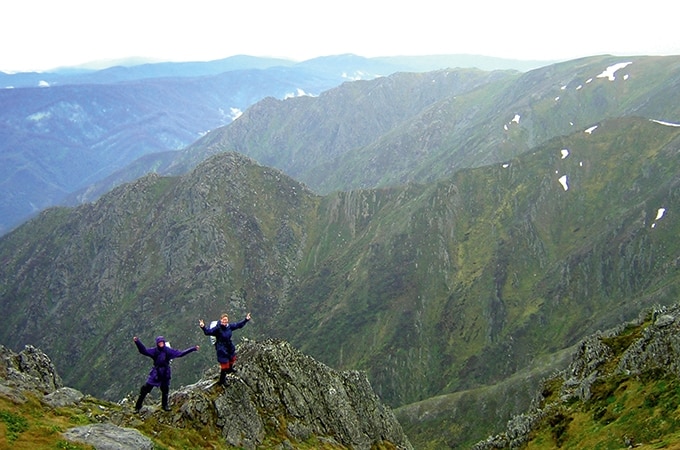Embark on an incredible six-day driving holiday along South Africa’s Garden Route for an adventure of a lifetime with this guide. Explore a remarkable stretch of coastline known for its natural beauty, diverse wildlife, and vibrant culture. From the rugged cliffs of Tsitsikamma National Park to the coastal towns of Knysna and Plettenberg Bay, this itinerary promises awe-inspiring moments at every turn.
Those spellbinding views of Table Mountain. Our soul-stirring strolls and bike rides beside the Atlantic Ocean. That dreamy ferry ride to Robben Island. Those juicy seafood platters at the Victoria and Albert waterfront.
Cape Town has provided a treasure trove of beguiling holiday memories. It’s a shame we have to leave but after a fabulous week in the ‘Mother City’, leave we must. On the doorstep, you see, lies one of the world’s great road trips. There’s no way we’re coming to South Africa and not doing the Garden Route.
Some couples imagine this entails driving past a string of pretty lawns carpeted in bright, blooming flower beds. The Garden Route is so-called, however, because its luxuriant, forest-fringed coastal landscapes contrast so starkly with the country’s semi-arid, outbackesque interior.
Technically, it sweeps around 200 kilometres from the harbour town of Mossel Bay, 390 kilometres east of Cape Town to Storms River, 170 kilometres west of Port Elizabeth (PE). To most tourists, though, the Garden Route means Cape Town to PE.
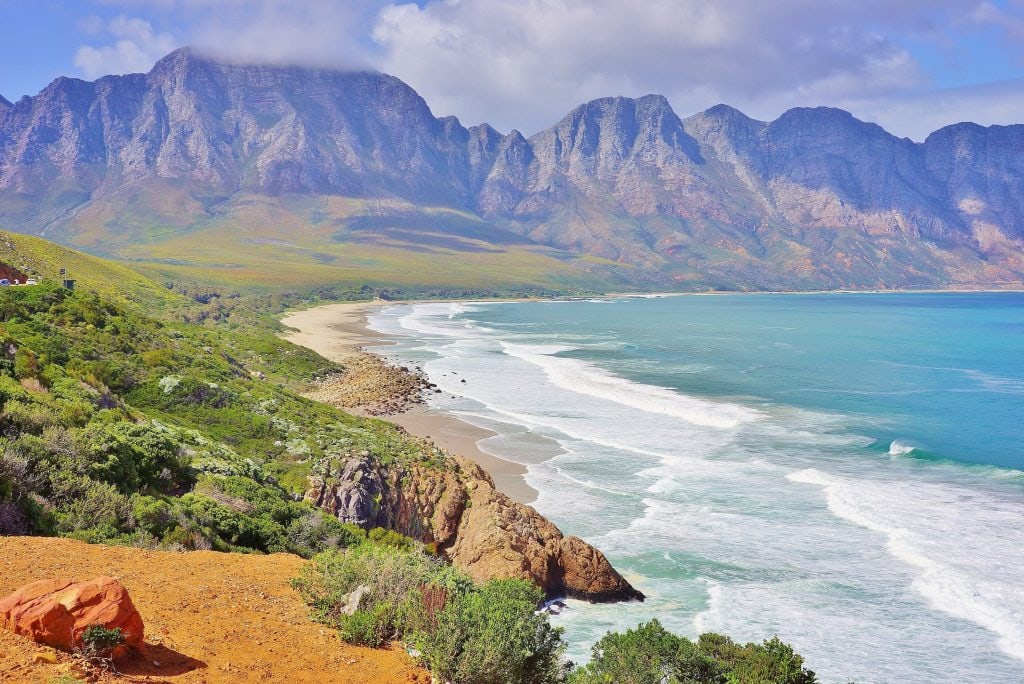
Day one
The quickest way to Mossel Bay is via the N2 highway that threads inland through undulating wheat fields, sloping vineyards and the Sir Lowry’s mountain pass. From the top are magnificent vistas of the Cape Peninsula, the finger of land pointing south of Table Mountain towards the Cape of Good Hope, but what’s the rush? About 30 minutes outside Cape Town we deviate off the N2 and onto Route 44, a breathtaking coastal drive that winds past a chain of sleepy seaside villages.
It then joins Route 43 into Hermanus, one of the planet’s best land-based whale watching destinations. We’ve come out of season. The southern right, humpback and Bryde’s whales are usually spotted between June and November but a little further along, at the town of Gansbaai, there’s the opportunity to glimpse another mammoth maritime creature.
John Williams’ bone-chilling Jaws soundtrack races through my head as we cut through frigid Atlantic waters on a boat operated by Marine Dynamics. They are a conservation trust that gets tourists up close and personal with great white sharks. Attracted by colonies of African penguins and Cape Fur seals, these giant predators prowl the sea year round.
Eschewing the chance to go nose to nose with them on a cage-diving experience, we observe the cagerattling shark/human interactions from the safety of the boat deck, our hands warmed by steaming mugs of hot chocolate. “Wow, this is amazing,” is a statement heard more than once during this unforgettable voyage.
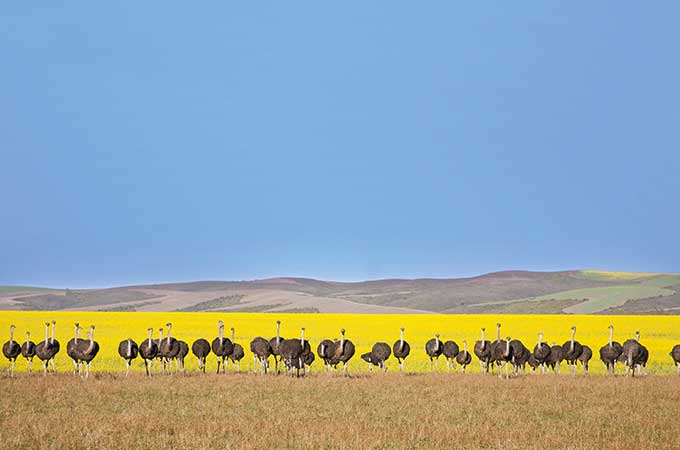
Day two
We have a week to reach Port Elizabeth, so we’ve plenty of time to make another detour off the Garden Route ‘proper’. A 45-minute drive inland from Mossel Bay, Oudtshoorn is touted as the Ostrich capital of the world. It boomed at the turn of the 20th century, when the town’s ‘feather barons’ grew rich from the global demand for fashionable feather boas and hats.
A tourist industry has since mushroomed around these huge flightless birds, the big cousins of Australia’s emus. At the Cango Ostrich Farm we get to meet and feed these ravenous creatures. You can ride them, too if you weigh under 75 kilograms. You can also taste them, both at the farm’s on-site cafe where they serve ostrich burgers and eggs and in an Oudtshoorn town centre studded with ‘Ostrich Palaces’.
These graceful sandstone mansions were constructed with the profits of the feather industry. We savour tender ostrich fan fillets with a few glasses of Stellenbosch shiraz at the smart, unpretentious Bello Cibo restaurant. The bill? About $15 per head. We find most things in South Africa especially wining and dining outrageously good value.
Related Article: The Best Romantic African Safaris
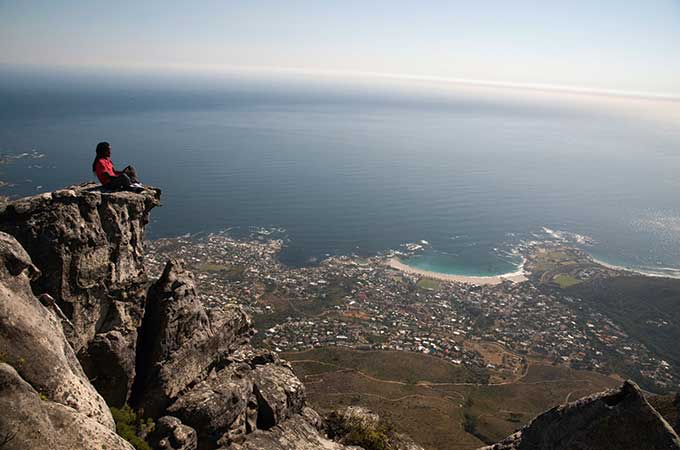
Day three
We’re up before dawn to join one of Devey Glenister’s highlyrated tours. Nicknamed ‘Meerkat Man’, Devey guides tourists onto Oudtshoorn’s parched outskirts to watch meerkats emerge from their underground hovels and toast themselves in the rising sun. Thanks to Devey’s fascinating commentary, we’re shocked to discover that these incredibly territorial mongooses are not quite as adorable as they look. Apparently they make the worst pets.
Later, back on the official Garden Route, we drive into the seaside town of Wilderness on the multi-lane N2, and think what an inappropriately named place this is. Until that is, we park up and head down to the beach. Appearing to stretch into eternity, this whitesand wonder is virtually deserted as we saunter along its soft grains, past wavering palm trees and along a shoreline kissed by rolling blue waves. In between the gorgeous beach and Wilderness’ tiny town centre, we pause at Beejuice Cafe. Housed in the old railway station, it’s a nice spot for coffee, fresh local produce and tapas-style snacks. We spend the evening browsing the artisanal craft stalls and enjoying live music at Wilderness’ hippy-chic Friday night market.
Related article: A Complete Guide to Visiting South Africa
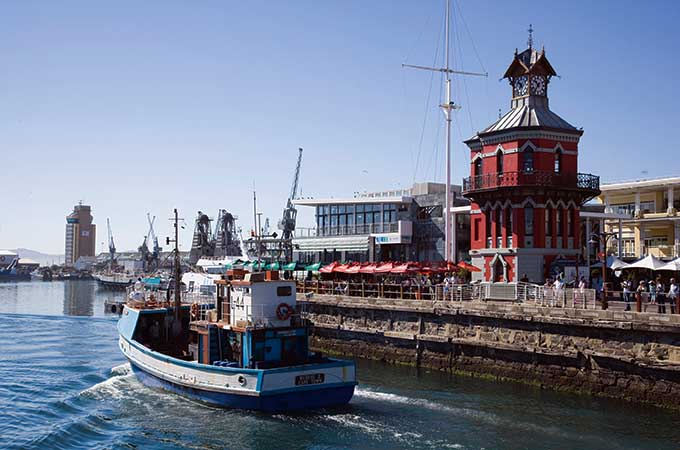
Day four
Wilderness has some lovely little lagoons, enlivened by birdlife, but they’re no match for the huge pool of water edging the Garden Route’s most popular resort. Hugged by subtropical forest, Knysna Lagoon captivates at first sight and is perfect for a languid mid-afternoon cruise. The town centre isn’t that photogenic, but Knysna’s edges, peppered with desirable lagoon-side hotels and spas like the sleek Villa Afrikana Guest Suites certainly are. We drive up to a vantage point overlooking the Knysna Heads, a pair of towering sandstone bluffs perched where the lagoon, fed by the Knysna River, flows into the Indian Ocean.
Knysna can get ultra-busy at times, especially around the January school holidays and during its annual Oyster Festival but we found the shoulder season between summer and autumn just right.
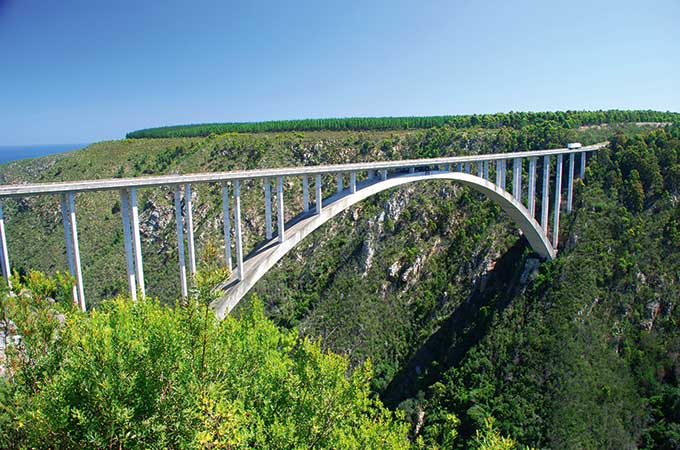
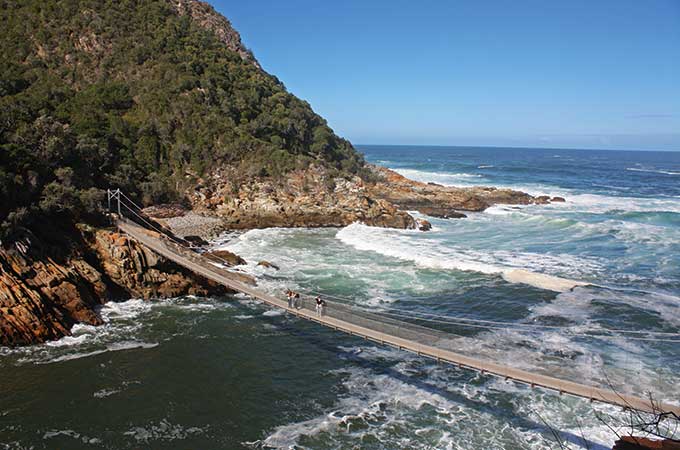
Day five
Rubbing shoulders with the locals, we kick off this sunny Sunday morning with brunch on the terrace of The Lookout, a popular restaurant nestled by the spectacular curving beach of Plettenberg Bay, 30 kilometres east of Knysna. After a recommendation by the friendly waitress, we order scrumptious Eggs Benedict, then burn off the calories with a walk along a beach peopled with joggers, amblers, surfers and sunbathers.
Afterwards, uphill in Plett’s neat town centre, we ogle stylish fashion boutiques and swimwear outlets, and get a caffeine boost at Le Fournil de Plett, a pleasant French-style patisserie. Then we head to Tenikwa. A sanctuary that rehabilitates injured animals and birds, this is one of the several wildlife reserves along the Garden Route and boasts a large collection of African wild cats. It’s a spine-tingling experience to follow the rangers into enclosures with caracals, servals and cheetahs, and we also get to see Tenikwa’s resident baboons, honey badgers and penguins.

Day six
Our last pit stop is Storms River Village, a tranquil base at the heart of Tsitsikamma National Park. Characterised by lush mountainous forests, plunging ravines and pristine coastline, Tsitsikamma straddles the country’s Western and Eastern Cape regions and is, for many (ourselves included), the most attractive section of the Garden Route. Adventure-minded couples are in their element, with all sorts of activities on offer including kayaking, kloofing (canyoning), tree canopy swings and bungee jumping. The 216-metre Bloukrans River Bridge is the world’s highest commercial bridge bungee.
Hardcore hikers will love the Otter Trail. A 42-kilometre jaunt from the heart of Tsitsikamma to the hamlet of Natures Valley, it’s regarded as South Africa’s best walk and usually takes five days. We tackle the first three kilometres of this route. Known as ‘the waterfall trail’, this fun, seaside spectacle is a three-hour return from the national park’s main visitor centre, and comprises lots of clambering up and down giant boulders and skirting along snaking soil trails.

If you’d prefer something more laid-back, you can hire mountain bikes and Segways from Tsitsikamma Backpackers in Storms River Village. This eco-friendly hostel set in peaceful landscaped gardens is lovely and may shatter your preconceptions of what 21st century backpacker’s accommodation is all about.
The Storms River Village centre is dotted with eateries, including De Oude Martha set inside the quaint Tsitsikamma Village Inn and specialises in home-cooked African recipes. A few doors down is Marilyn’s, a quirky 1960s-style American diner and host of an annual Elvis festival.The next day, we drop the car off at Port Elizabeth airport, a little tired but thrilled with what we’ve seen and done in and around the Garden Route.
Quite simply, it had been a wonderful week of discovery and exploration, and if we had more time, we’d happily drive all the way back to Cape Town.
Related: Your complete travel guide to South Africa
Need to Know The Garden Route, South Africa:
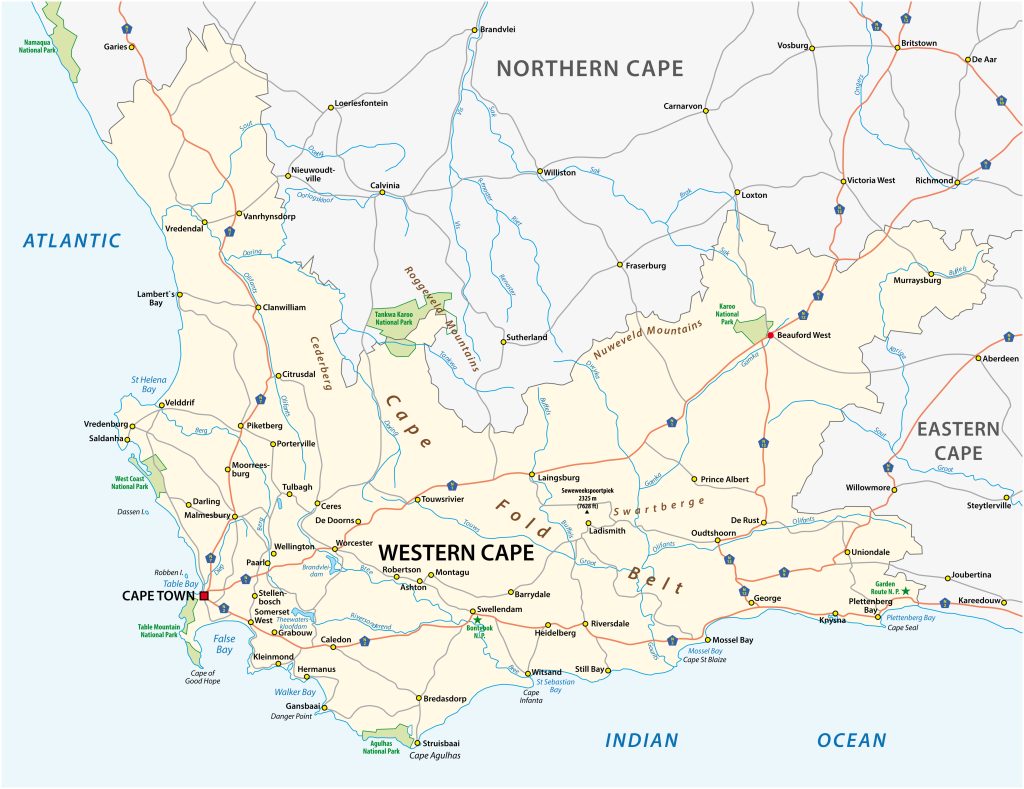
There are scores of hire companies in Cape Town. Most will let you drop the car off in PE for a small fee. Petrol is likely to be your main expense.
The Route at a Glance: The Garden Route is a scenic drive that stretches along the N4 highway from Mossel Bay to Storms River. It is a popular route that includes stops at George, Wilderness, Knysna, and Plettenberg Bay. Most people access the Garden Route from Cape Town, and the journey to the starting point can include visits to heritage sights in Swellendam or whale-watching in Hermanus. After reaching Storms River, travelers have the option to either loop back to Cape Town, taking the R62 for a different view, or continue on for 104 miles to the city of Port Elizabeth, with a possible stop at the famous surfing spot of Jeffrey’s Bay.
When is The Best Time to Visit? The spring and summer months, from September to April, are highly recommended. During this time, you can enjoy warm weather, long daylight hours, and the beautiful blooming of fynbos flowers.
How Long Does it Take To Drive The Garden Route? If you’re planning a road trip along the Garden Route, it is recommended to allocate at least six nights as per our itinerary above if you’re travelling to or from Cape Town. However, even with a two-week trip, it’s still possible to not see everything the Garden Route has to offer. On the other hand, if you’re starting from Port Elizabeth, you can see the main highlights of the Garden Route in just three days.
What to Pack for The Garden Route? As it’s important to pack appropriately for the weather., check the forecast closer to the time you travel. Since the Garden Route is located in a coastal region, even in the summer, temperatures can be cooler. Therefore, it’s a good idea to pack layers and clothing that will keep you comfortable in varying temperatures. If you’re an adventurous traveler and plan on exploring the numerous hikes, rivers, and lakes in the area, it’s recommended to pack suitable footwear. While you don’t necessarily need heavy-duty hiking boots, it’s important to have shoes that will provide safety and comfort during long hikes.
Read More: The Ultimate Three Country African Holiday or Honeymoon.
